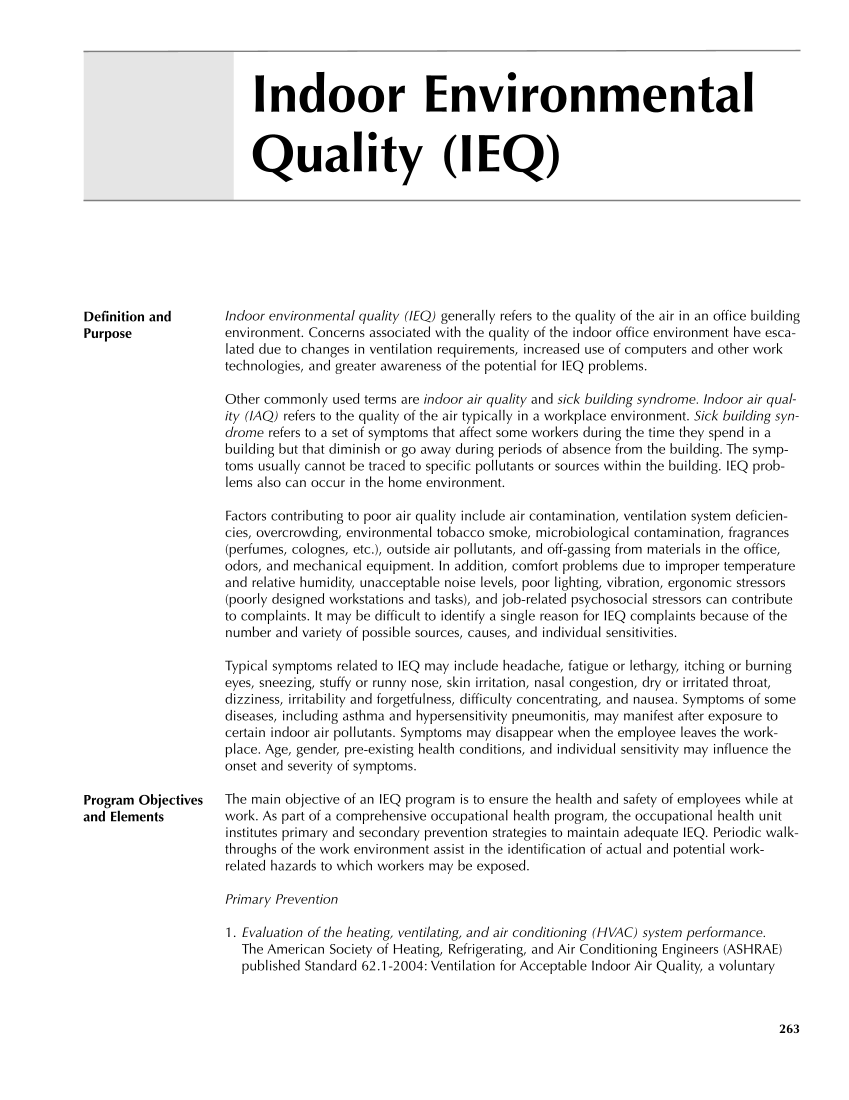Indoor environmental quality (IEQ) generally refers to the quality of the air in an office building environment. Concerns associated with the quality of the indoor office environment have esca- lated due to changes in ventilation requirements, increased use of computers and other work technologies, and greater awareness of the potential for IEQ problems. Other commonly used terms are indoor air quality and sick building syndrome. Indoor air qual- ity (IAQ) refers to the quality of the air typically in a workplace environment. Sick building syn- drome refers to a set of symptoms that affect some workers during the time they spend in a building but that diminish or go away during periods of absence from the building. The symp- toms usually cannot be traced to specific pollutants or sources within the building. IEQ prob- lems also can occur in the home environment. Factors contributing to poor air quality include air contamination, ventilation system deficien- cies, overcrowding, environmental tobacco smoke, microbiological contamination, fragrances (perfumes, colognes, etc.), outside air pollutants, and off-gassing from materials in the office, odors, and mechanical equipment. In addition, comfort problems due to improper temperature and relative humidity, unacceptable noise levels, poor lighting, vibration, ergonomic stressors (poorly designed workstations and tasks), and job-related psychosocial stressors can contribute to complaints. It may be difficult to identify a single reason for IEQ complaints because of the number and variety of possible sources, causes, and individual sensitivities. Typical symptoms related to IEQ may include headache, fatigue or lethargy, itching or burning eyes, sneezing, stuffy or runny nose, skin irritation, nasal congestion, dry or irritated throat, dizziness, irritability and forgetfulness, difficulty concentrating, and nausea. Symptoms of some diseases, including asthma and hypersensitivity pneumonitis, may manifest after exposure to certain indoor air pollutants. Symptoms may disappear when the employee leaves the work- place. Age, gender, pre-existing health conditions, and individual sensitivity may influence the onset and severity of symptoms. The main objective of an IEQ program is to ensure the health and safety of employees while at work. As part of a comprehensive occupational health program, the occupational health unit institutes primary and secondary prevention strategies to maintain adequate IEQ. Periodic walk- throughs of the work environment assist in the identification of actual and potential work- related hazards to which workers may be exposed. Primary Prevention 1. Evaluation of the heating, ventilating, and air conditioning (HVAC) system performance. The American Society of Heating, Refrigerating, and Air Conditioning Engineers (ASHRAE) published Standard 62.1-2004: Ventilation for Acceptable Indoor Air Quality, a voluntary 263 Definition and Purpose Program Objectives and Elements Indoor Environmental Quality (IEQ)
Purchased from OEM Press by (ge corporate access). (C) 2013 OEM Health Information, Inc. All rights reserved.












































































































































































































































































































































































































































